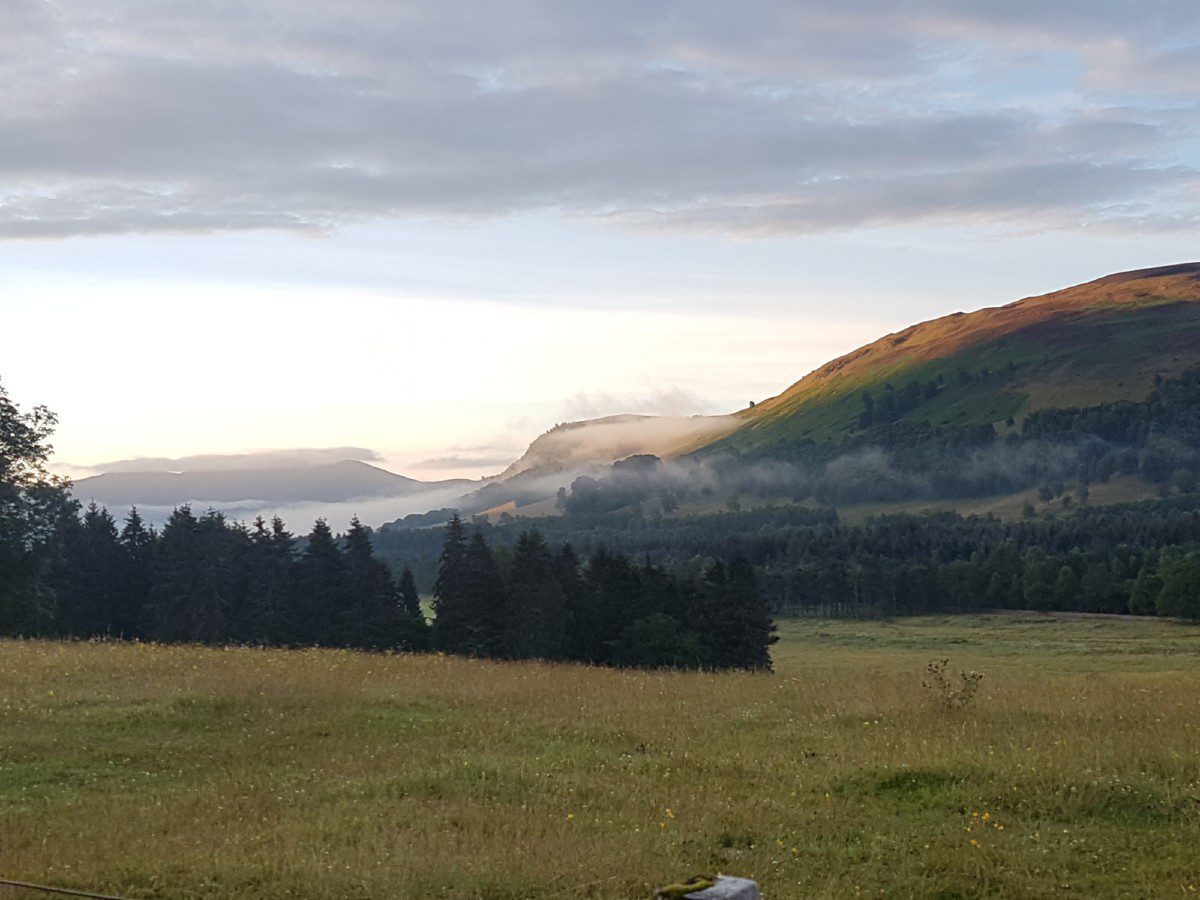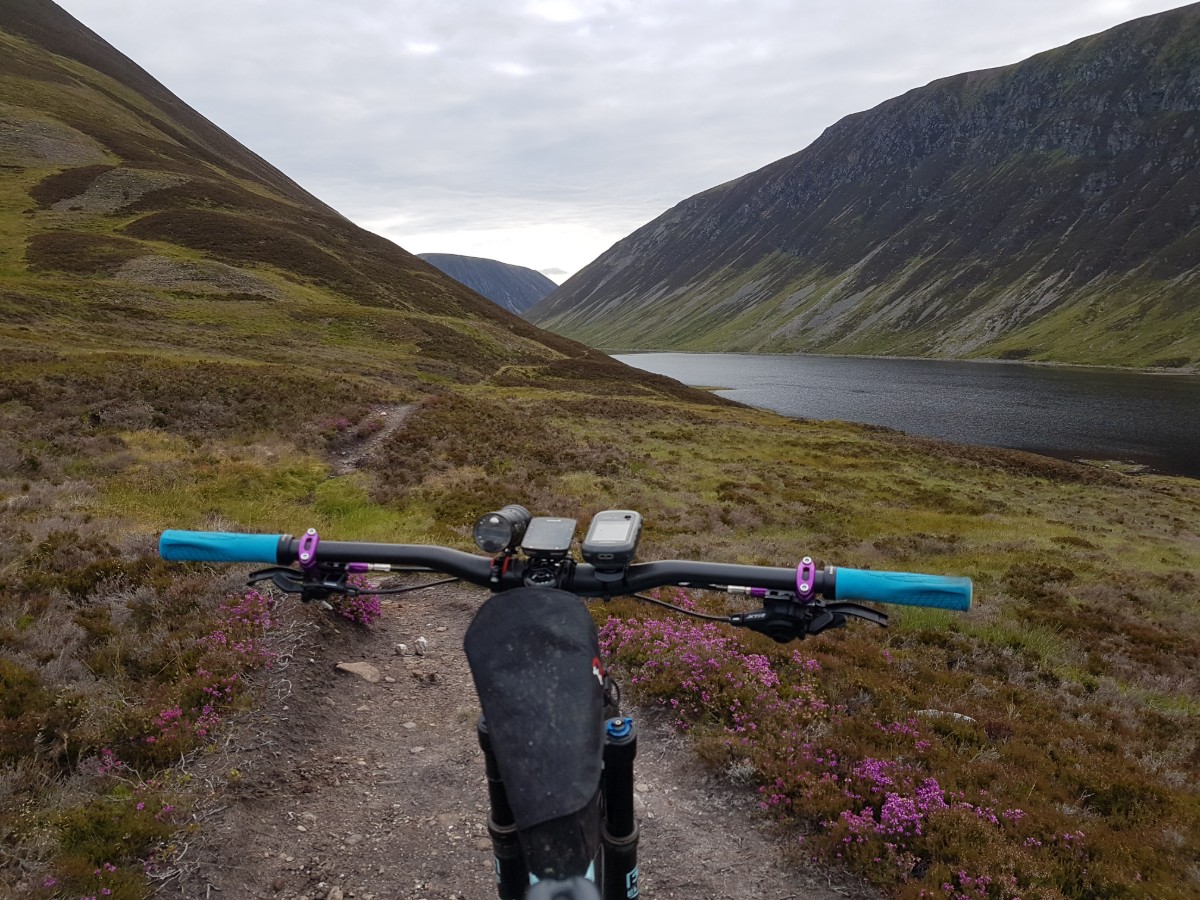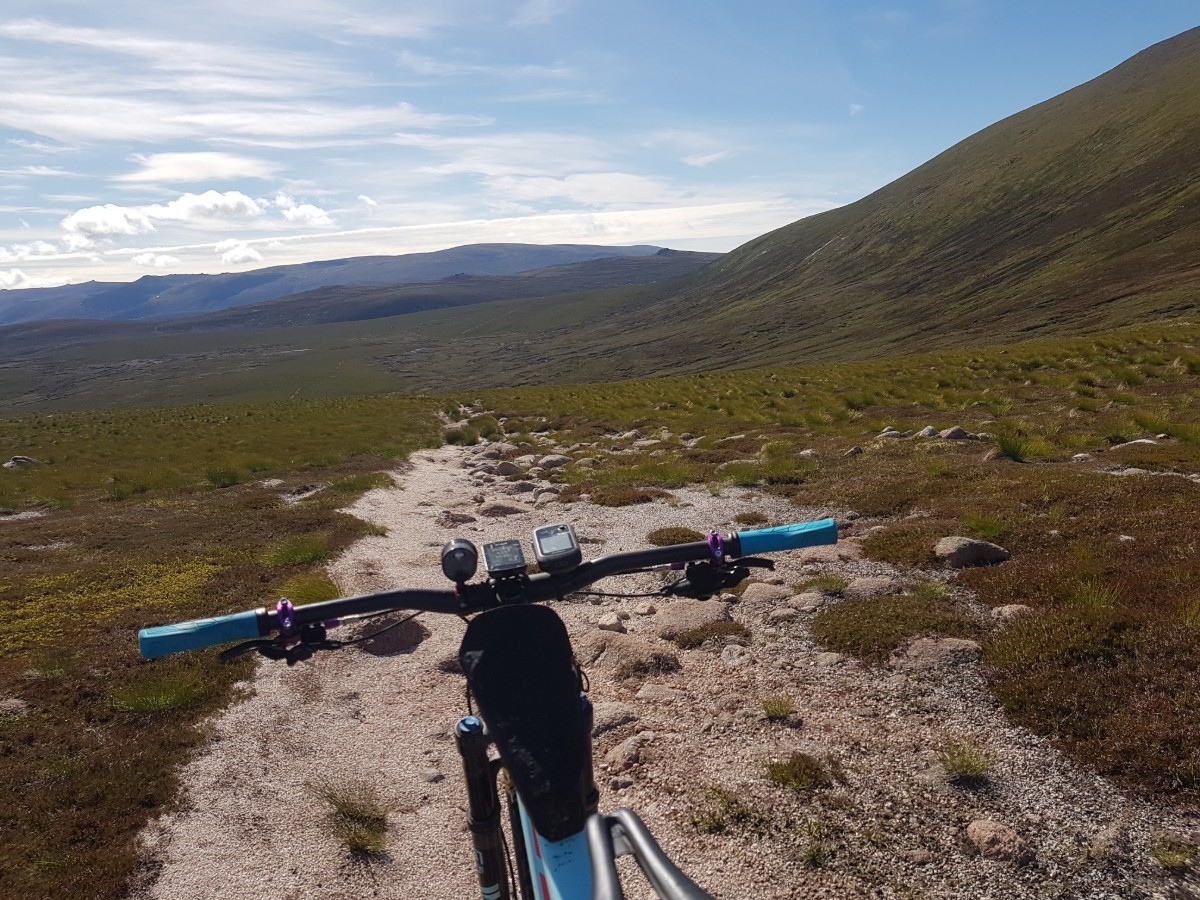Blog
stories • happenings • adventures
A couple of weeks ago, I took advantage of a dry spell to have a go at a fast ride on the Cairngorms Loop. I’ve ridden most of the loop many times, but somehow have never gotten around to riding all of it continuously. Based on what I knew and other people’s rides, I figured a sub-24hr ride shouldn’t be too demanding, and that sub-20 should be a reasonable target. Structured training had pretty much been keeping me sane since the world stopped in March, and the miles of long, mixed-surface riding in Fife through Spring had me feeling fairly strong. I rolled out of the van at 0530 on a Friday morning to clearing mist and early sunshine, packing enough food for 21 hours, a couple of bottles, tools and spares and a warm top and waterproof jacket. It felt good to be riding so light and aiming so long.
The early road miles up Glen Garry on the cycle route are an easy way to warm up early-morning legs, and I saw a couple of early morning bikepackers heading south into the emerging sun. As I left the A9 and headed north towards Gaick Pass I wanted to put my mind in a good place by repeating the mantra of ‘patience’ that I had gotten from Kait Boyle in Arizona last year, and which had helped me to a fast ride on the AZT300. I find more and more that when positivity and focus come together they result in a fast ride over long distances, and that always starts with accepting a mellow, patient pace from the start if you are to keep it up over the long haul. The time for pushing and fighting comes later.

Glen Garry at Dawn
Not that the Gaick is slow, and before I knew it I was riding the enjoyable singletrack of Loch an Dùn and rolling past Gaick Lodge down toward Strathspey. That’s the best thing about the Cairngorms Loop, and particularly of doing it in one hit — every hour brings a different drainage crossing, a new river to follow, an area of different geology or history. Speaking of history, Gaick Lodge is the scene of one of Scotland’s worst avalanche incidents, where 5 men and their dogs were killed by a slide during the night, which demolished the cottage they were staying in.
4 hours were on the clock when I passed Glenmore Lodge and the end of the first (very fast) 80km, which I knew was a reasonable pace, but again I shouted internally ‘patience!’ and concentrated on eating well to prepare for the physical, technical section from Bynack Stables through to Glen Derry — the mountain section! I somehow got the impression that I didn’t like the Bynack Mor trail when I first rode it, and while it is a bit of a straight-line descent with some brutal water bars, as a climb I think it’s excellent. Around halfway up I saw a bike with rear wheel removed lying beside a guy looking flustered, and sure enough when I pulled up he said he had a puncture and no pump… So I did my good samaritan act while trying not to look like I was looking at my watch too often, to get him back on his way. Stopping felt like an acknowledgement that there was no hurry, in a way, and that time wasn’t the priority.

Singletrack through Gaick Pass

Heading over the shoulder of Bynack Mor

The best bit!

The summit of the Lairig an Laoigh
Once you leave the cairn at the junction for the summit, the trail becomes fantastic and infuriating, by turns. It’s a lumpy, technical antithesis to the first 80km, and your average speed plummets. It’s also my favourite type of riding, and as hard as it is I know that I have an advantage there, which makes it doubly fun. There is a rhythm to be found among all the water bars and boulders, so I searched for it as I crossed the Avon with dry feet at the fords, and hopped on and off the bike up the Lairig an Laoigh, before enjoying the long, rewarding descent down Glen Derry and out to Derry Lodge. This mountain section was dry-ish, but not as dry as I would have liked as the muck made itself heard in my chain and brakes.
Two new rivers, the Dee and then the Geldie, gave some welcome increase in speed along landrover tracks through the warmth of midday, although the high sun was feeling a bit warm as I climbed on to Geldie Moor and began the 6km of bleak singletrack to take me through to the Feshie drainage. Thankfully, the moor was fairly dry, and as I pulled up to the bridge over the Eidart to fill my bottles there were 8 hours on the clock. I got an inkling that this was fairly fast, but I had no splits or frame of reference time-wise for the second half of the route once I got back to Feshiebridge, so as I rejoined tarmac at Achlean I cleaned and lubed my chain, ate a little bonus treat of wine gums, and felt fairly good taking up the strain on legs and lungs for the long tarmac drag back through Strathspey.
The road is boring, but it adds some welcome miles on to the total distance. Getting to Forest Lodge in Nethy Forest, I knew the way to Eag Mhor through the many forest tracks (more on that later). Once through the ‘Big Egg’ and across the Dorback Burn, the hill roads through to Glen Brown, Tomintoul and then up the Avon were the hardest of the ride. It was late afternoon, I was at the furthest point from the start, and I was feeling the 12 hours of pedaling. There was also a big old headwind trying to waft me back down the glen. Eating and drinking were the priority as I winched over the high pass of Cullardoch and along the Dee again to Braemar. The food I’d brought was getting to be a chore with too many heavy, date-based bars, so I treated myself to a quick stop at the Co-op in the village to get a bottle of Coke and some chocolate Hobnobs (pro tip: these two things combined make you go fast!) And so I met my own track for the second time at Linn of Dee at 1800, and I finally felt like I was getting toward the home straight.
It was actually a few years since I had ridden the section from Bynack Lodge through to the Tilt. Now it felt like the Patience and Consistency phases of the ride had ended, and it was time to let it all hang out with whatever energy I had left. Thankfully I had just enough daylight left for the steep, narrow and precarious rollercoaster ride down the singletrack beside the growing river. I felt the odd kind of euphoria that I only associate with long bike rides at odd times of day, although I think some of it might have been the bottle of Coke I gulped before the singletrack. I actually got a little carried away and overshot the turning across the river to the infamous ‘sting in the tail’ section, but only by a couple of hundred metres to the Tarf Bridge, so no harm done.

Fording the Feshie

Thieve’s Pass

The Glen Tilt Rollercoaster Part 1

The Glen Tilt Rollercoaster Part 2
The sting in the tail is just that! A steep, steep push up and away from the river takes the rider into complicated, remote topography just when Blair Atholl seems within reach down the Tilt… But it’s dramatic, and saves some brilliant riding for the end. The Hobnobs kept me going up the long climb past Fealar Lodge, into the gathering gloom and the first spatters of rain from a warm front which had been approaching all afternoon. Luckily it stayed mild and the rain was light, so I got the lights on and tried to use energy efficiently on the second climb from Daldhu towards Coire Lagain on the grassy singletrack. In the dark and with the increasing rain, it was quite a sporty bit of singletrack on which to keep speed! Soon enough, I was dropping like a stone down the road towards Blair Atholl, and I pulled up at the train station a little before midnight, with 18 hours and 30 minutes elapsed on my Garmin.
What had been a very enjoyable ride had also been a fast one, shaving 30 minutes or so from Chris Hope’s 2016 ride to set a new record…
…Except I didn’t.
Way back in Nethy Forest I had ridden what I knew to be ‘the way’ to Eag Mhor, not even looking at the GPS track because I’m very familiar with the area. It was only later, once I’d slept, cleaned up and sent the track over to Steve Wilkinson, that he pointed out the 2.5km deviation, and I realised I’d made a mistake. Steve was super understanding and open to a conversation about it: as one of the founding figures of UK self-supported racing he knows better than most that this form of racing lives and dies by the integrity of its participants — Alan Goldsmith, the other shepherd of our little UK self-supported flock, once DQ’ed himself from his own race for borrowing a shock pump. After chatting we were no nearer to an answer, and Steve let the final decision rest with me.
I was in a pickle: ultimately, the deviation hadn’t reduced the distance and my ride was faster than the old record. On the other hand, I’d ridden fast landrover track when the real route took singletrack; I wasn’t sure it was fair to Chris to have his ‘fair and square’ time taken away by one that would always have a little niggle of controversy. What’s a record worth if it always has to be qualified a little, rather than standing on its own two feet? More importantly, I wondered if I was losing track of priorities and forgetting what really mattered: I’ve said before that the day I begin to race against other people rather than the clock in these types of things is the day that I’ll stop. To have started and ended the ride with positive feelings of self-awareness, presence and acceptance would be a waste if it was lost to wondering about how it stacked up relative to someone else. With such a simple ‘race’ format, there should be no space left for grey areas or debate. The nature of the discrepancy didn’t matter so much as the fact that there was one, and I couldn’t imagine that ever sitting quite right or being fun to explain every time it came up; humming and hawing over it was already beginning to detract from the satisfaction of the day itself, and I didn’t think that the feeling would go away.
I decided to retract the time. I didn’t ride the exact same route as Chris, therefore I didn’t break his record. It was no different to borrowing a shock pump for example — it was an arbitrary decision to scratch the time, but then the whole enterprise is arbitrary from the start, and small route deviations (or a shock pump) can erode the legitimacy and importance of big routes over time. It felt more like a question of what’s important to me, and what feeds my desire to commit physically to big rides. Feelings are just as important as numbers on long bike rides, I think, and this was perhaps a small but important way to remind myself why I’d set out that morning in the first place , that the ride and the record can be separated, and the value of one does not depend on the other. More importantly, I’ll surely be back to ride it again soon, and when I do I’ll be repeating the same words as last time in my head, and hoping to enjoy every minute just as much.
4 Weeks Later
August 24th might well have been the last weather window of the year, or at least the last one with enough daylight left to navigate Glen Tilt before dark. I knew that my body was capable of putting in another fast ride, but I wasn’t totally convinced that my head was in it for another 18hrs+ of concentrated effort. Scarier than that though was the thought of having to sit an entire winter and early summer, waiting for darkness to pass and snow to melt before being able to put right the mistake I made on the last ride. So, with a 0430 start I retraced my steps. In the end I think the trail did the hard work for me, and I fell back into that elusive euphoric headspace like a settling into a familiar chair. It was only four weeks since the first ride, but the brief vignettes I saw during the day told a very different story: the first golden leaves, fading heather flowers and a sense of seasons changing; a chance to wave goodbye to the hills in their summer dress until next year. Familiarity worked as a tactic, and despite a slightly slower moving average I arrived at Blair Atholl station in 18:23, a smidget faster than last time, and having gone the right way this time.
The time itself is just a full stop at the end of the journey. The appeal of riding bikes, whether it’s against the clock or not, is the learning that comes from the journey. In this case, the mistake I made first time round opened up the possibility to learn more about why I wanted to do the ride in the first place, forced me to decide what my priorities are, and ultimately allowed a second visit to that wonderful, fleeting sensation that happens when you pack light, travel far and let your mind lose itself in the land beneath your wheels. It was, literally, about much more than pedaling circles.
If you haven’t already, check out the Cairngorms Loop site or the Bikepacking.com route guide.
The route is a gem, and takes you to so many quiet, beautiful and varied spaces in the sprawling landscape of the Cairngorms. It’s just as wonderful when taken at a more relaxed pace over 4 or 5 days, or a whole week if it’s blueberry season!
Huw’s favorite thing to read is a map – when he moved across the border to Scotland, the first thing he did was buy one. Bikes are a good way to check that the map wasn’t lying, and the resulting trips have taken him to nearly every bog in Scotland, to Patagonia, Nepal and Arctic Lapland. The odd bikepacking race thrown in for good measure keeps him honest. More recently, the addition of a packraft meant that even the blue bits of the map are fair game! Occasionally, he works as an outdoor educator and mountain bike coach, hoping to show other people why they ought to read more maps, too. His blog is Topofests.com.

